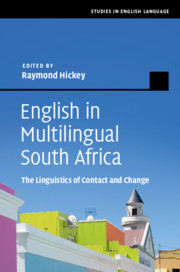Book contents
- English in Multilingual South Africa
- Studies in English Language
- English in Multilingual South Africa
- Copyright page
- Contents
- Figures
- Maps
- Tables
- Contributors
- Preface
- I A Framework for English in South Africa
- II Sociolinguistics, Globalisation and Multilingualism
- III Language Interfaces
- Chapter 12 Present-Day Afrikaans in Contact with English
- Chapter 13 Shift Varieties as a Typological Class?
- Chapter 14 Language Use and Language Shift in Post-Apartheid South Africa
- Chapter 15 English Prepositions in isiXhosa Spaces: Evidence from Code-Switching
- Chapter 16 Aspects of Sentence Intonation in Black South African English
- Chapter 17 The Development of Cognitive-Linguistic Skills in Multilingual Learners: A Perspective of Northern Sotho–English Children
- Chapter 18 Linguistic Interference in Interpreting from English to South African Sign Language
- Timeline for South African History
- Glossary
- Index
- References
Chapter 17 - The Development of Cognitive-Linguistic Skills in Multilingual Learners: A Perspective of Northern Sotho–English Children
from III - Language Interfaces
Published online by Cambridge University Press: 07 November 2019
- English in Multilingual South Africa
- Studies in English Language
- English in Multilingual South Africa
- Copyright page
- Contents
- Figures
- Maps
- Tables
- Contributors
- Preface
- I A Framework for English in South Africa
- II Sociolinguistics, Globalisation and Multilingualism
- III Language Interfaces
- Chapter 12 Present-Day Afrikaans in Contact with English
- Chapter 13 Shift Varieties as a Typological Class?
- Chapter 14 Language Use and Language Shift in Post-Apartheid South Africa
- Chapter 15 English Prepositions in isiXhosa Spaces: Evidence from Code-Switching
- Chapter 16 Aspects of Sentence Intonation in Black South African English
- Chapter 17 The Development of Cognitive-Linguistic Skills in Multilingual Learners: A Perspective of Northern Sotho–English Children
- Chapter 18 Linguistic Interference in Interpreting from English to South African Sign Language
- Timeline for South African History
- Glossary
- Index
- References
Summary
The importance of developing English skills early in contexts where it is to be used as medium of instruction is well documented, but there has been little systematic research in South Africa to determine whether the early introduction of English leads to balanced bilingual learners. This chapter focuses on the acquisition profiles of, and interrelationship between skills in, a sample of Northern Sotho–English bilingual children. Within this sample, one group received their schooling in Northern Sotho (their home language), with English being taught as a first additional language from Grade 1. The other group received their schooling in English from Grade 1, with Northern Sotho being taught as first additional language. Receptive vocabulary and phonological awareness were assessed in both languages. Correlational analysis of the data suggests that some linguistic skills are interrelated and transferable between Northern Sotho and English, despite the structural differences between these languages, whereas others are more dependent on instruction and not automatically transferable.
Keywords
- Type
- Chapter
- Information
- English in Multilingual South AfricaThe Linguistics of Contact and Change, pp. 350 - 370Publisher: Cambridge University PressPrint publication year: 2019

